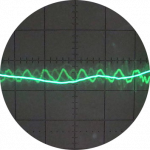How much radiator capacity do I need for an air source heat pump?
Posted by: @jamespaPosted by: @sunandairPosted by: @cathoderay@jamespa - I did say there is more than one method! Not everyone is familiar exponents and reciprocals! The Stelrad (there are others) conversion factor table is a more accessible/understandable/intuitive way of getting to the results.
just to throw the proverbial spanner in…. So this is only dealing with 40c flow temps during higher demand days. Whereas this doesn’t the solve the more frequent days of 10c and above ambients when the flow temps might be 30c 32c or 35c. This is the biggest need to overcome cycling caused by emitters not being specified to cope with heat transfer at lower flow temperatures.
I once did work out a correction factor down to 30c because the Stelrad charts didn’t go down that low.IMO these rad schemes really should take some account of low output needs and not just design temps at -3c
Not a real problem.
….. - ….
As regards cycling, the heat loss from the house at higher OATs is what it is, and upsizing the radiators doesn't change that. If the heat pump cant modulate down to the house heat loss then it cant modulate down and will cycle.
Dear @jamespa (moderator) do you really think it appropriate to dismiss out of hand comments which don’t align with your opinions.
The participants of these forums is very diverse.
I have seen you have a great deal of theoretical and mathematical contribution to make but perhaps these forums work best when a balance of theory, practice and mishap coalesce to produce empowering and useful results.
Balancing emitter sizes to reduce cycling in a heat pump installation is less black and white than you seem to think.
Posted by: @sunandairDear @jamespa (moderator) do you really think it appropriate to dismiss out of hand comments which don’t align with your opinions.
The participants of these forums is very diverse.
I have seen you have a great deal of theoretical and mathematical contribution to make but perhaps these forums work best when a balance of theory, practice and mishap coalesce to produce empowering and useful results.
Balancing emitter sizes to reduce cycling in a heat pump installation is less black and white than you seem to think.
I will concede that the first sentence was blunt and for that I apologise if offence was caused. It was intended to be succinct (surely a good thing), but I agree it came over as blunt (a bad thing).
That said I do think its entirely appropriate to question statements which appear not to be accurate and/or aren't backed up by examples/facts. It is also appropriate to question interpretations both of facts or theory. Robust debate is the only way to get clarity and I would actively encourage others robustly to question what I might say!
The original comment doesn't appear (as I understand it) to be about emitter balancing; it appears to be about sizing of emitters at high OAT/low FT and cycling and in particular a suggestion that calculating emitter sizes at design OAT is not sufficient, and that this needs to be done at higher OATs as well.
I haven't heard any evidence that it is of common (or even uncommon) practice to calculate emitter outputs at OATs higher than the design minimum and nor can I see why it would be necessary. The whole point of the WC curve, which is adjustable, is that, if the output of the emitter is correct at the design minimum, it will be (very nearly) correct at other OATs and the behaviour of common emitters more or less guarantee that this is the case. Even if you do this calculation for every emitter individually, what corrective action can you actually take that is consistent with getting sufficient output at low OAT?
As regards cycling, the issue/driving factor is not really, so far as I can see, whether the emitters (assuming they are sized correctly for the design OAT) can emit sufficient heat to keep the heat pump happy, its whether the house emits sufficient heat. Once the OAT has risen to the point where it doesn't then, however large the emitters are, the heat pump must cycle, unless you allow the IAT to rise above the design value or 'impose' cycling by heating part time. Unfortunately it seems that it is also relatively uncommon practice to calculate, or even consider, this point, but that all links back to the 'problem' of over-sized heat pumps and uncertainty in the sizing in the first place. Even if it were common practice, the question 'ok so its been calculated but what do you do with the answer?' still applies.
PS I definitely don't think balancing emitters is straightforward. In other posts I have advocated the need for a self-learning automated LSV that, over a period of several days, slowly does the balancing job, as it seems to me ambitious to imagine that installers will do this other than very approximately. Adia are working on exactly that as I understand their emerging technology (which does other things too). However balancing, even if perfect, wont stop cycling if the house loss is less than the heat pump min output.
4kW peak of solar PV since 2011; EV and a 1930s house which has been partially renovated to improve its efficiency. 7kW Vaillant heat pump.
Your reply is quite complex. I’ve also noticed on your HP roll call data that you are quoting 10kw of emitters. Is this based on the convention of quoting the DT50 rated value or are you quoting some other DTvalue.
And it looks like it’s a rounded figure do you know what the DT50 value of all your emitters amounts to?
Posted by: @sunandairYour reply is quite complex. I’ve also noticed on your HP roll call data that you are quoting 10kw of emitters. Is this based on the convention of quoting the DT50 rated value or are you quoting some other DTvalue.
And it looks like it’s a rounded figure do you know what the DT50 value of all your emitters amounts to?
10kW is based on the design FT of 45. Most of the upstairs emitters are rather 'oversized' (for FT45) because I upgraded them before I realised quite how much the GIGO Fabric spreadsheet method can overestimate heat loss. Thus these emitters are turned down quite a lot on the LSVs or in a couple of cases on TRVs.
Downstairs emitters aren't 'oversized' (for FT45) by much because by the time these were done (by my installer) Id got a better handle on heat loss. Im actually running at 42 at the design OAT of -2.
The unrounded FT45 (DT22.5) output is 10.5kW, the DT50 output total is 29.4kW. At FT42 the emitter total output is calculated as 8.8kW, still (in theory) a bit more than the house loss. But of course some are turned down on the LSVs to balance them, which presumably accounts at least in part for the difference.
4kW peak of solar PV since 2011; EV and a 1930s house which has been partially renovated to improve its efficiency. 7kW Vaillant heat pump.
@jamespa interesting stats and it wasn’t what I was expecting.
So for many people reading this it might be considered nearly 30kwh (@DT50)of emitter capacity for a 7kwh heat pump you might indeed have oversized your radiator sizes so there would be no need to over compensate for low flow temp output during moderate ambient temperatures.
Or alternatively if a scheme based on 40c but working on a bigger margin of error adjusted to 45c flow which would result in the same increased capacity.
For whatever reason your stated 42c would imply it is somewhat over sized. With inherent benefits for low temp operation.
Your stats suggest you already know the output capacity for lower flow temperatures but for clarity I’ll list the capacity of 30kwh of emitters at DT50 rating.
30 kWh Radiator output capacities at low flow temperatures. (LWT)
At 35c flow temp. = 4.95kwh
At 30c flow temp. = 2.55kwh
At 25c flow temp. = 1.12kwh.
The above are based on 20c room temp and 5c circDT.
so the issue of low flow temperatures and mild climate is covered by your capacity at 35c but not covered at 30c and 25c If your HP has a minimum output higher than 2.5kwh.
The issue of Target Room Temp and practical tactics to maximise capacity while close to target will be addressed as an edit to this post
Posted by: @sunandairSo for many people reading this it might be considered nearly 30kwh (@DT50)of emitter capacity for a 7kwh heat pump you might indeed have oversized your radiator sizes so there would be no need to over compensate for low flow temp output during moderate ambient temperatures.
Just for clarity my numbers, collected together, are:
- Design OAT: -2
- Design FT @ -2: 45
- Measured house loss @-2: 7kW
- Rated output of '7kW' Vaillant heat pump at -2/45: 8.5kW (using o/p proportional to DT^1.3)
- Theoretical emitter capacity @45C (DT 22.5): 10.5kW
- Theoretical emitter capacity at DT50: 29.4kW
- Actual FT at -2 to achieve design IAT: 42C (ie the actual WC curve I am running on, determined experimentally)
- Theoretical emitter capacity @42: 8.8kW (using o/p proportional to DT^1.3)
- Note that some emitters are known to be oversized and are 'turned down' so it seems likely that this accounts for the difference between 8.8kW and 7kW
The conclusion I reach is that the least oversized emitters are 'correct sized' at 42 (not 45 as nominally designed); others are oversized at this FT and are turned down to compensate. Im not particularly surprised that the actual FT required is a bit lower than the design, given that some emitters are oversized and these is at least some sharing of heat between rooms.
The curve seems to work well enough for OATs between -1 and +11; I will have to wait to see what it does above +11. I may need anyway to set a min FT of 30 because I have a fancoil which (very annoyingly) only triggers at 30, a figure which cant be adjusted. I may alternatively find that the room in question (which benefits from cooking and solar gain) is warm enough from adjacent rooms anyway, or alternatively I may hack the controller! Once OAT reaches 12C its not quite so critical anyway!
4kW peak of solar PV since 2011; EV and a 1930s house which has been partially renovated to improve its efficiency. 7kW Vaillant heat pump.
@jamespa also I do take your point about set room temperature being the cut off point but a room is not an homogeneous space there are temperature gradients from floor to ceiling, cold spots in corners and different rooms with higher temp needs. In this graduated temperature environment energy will find a way to offload if the emitter reservoir is big enough.
In most cases of cycling there is only a need to postpone shutdown by 20 minutes or so to make cycling an acceptable event. And of course with reduced cycling comes improved CoP.
Posted by: @sunandair@jamespa also I do take your point about set room temperature being the cut off point but a room is not an homogeneous space there are temperature gradients from floor to ceiling, cold spots in corners and different rooms with higher temp needs. In this graduated temperature environment energy will find a way to offload if the emitter reservoir is big enough.
In most cases of cycling there is only a need to postpone shutdown by 20 minutes or so to make cycling an acceptable event. And of course with reduced cycling comes improved CoP.
Agreed, Put another way it may sometimes be better to heat the house to a slightly higher temperature to avoid cycling. I can easily believe that is the case around the temperature of onset of cycling (whatever that may be for your heat pump set up).
4kW peak of solar PV since 2011; EV and a 1930s house which has been partially renovated to improve its efficiency. 7kW Vaillant heat pump.
Follow-up: it occurs to me that the difference between flow and return temperatures is potentially a good indicator of whether you have enough radiator capacity, at the design flow temperature and max design flow rate. If the temp drop isn’t as big as the design says it should be, you aren’t shedding as much heat into the house as you need, in order to use the full HP output. So more emitters needed.
- 26 Forums
- 2,342 Topics
- 53 K Posts
- 252 Online
- 6,000 Members
Join Us!
Worth Watching
Latest Posts
-
RE: Commencing on an ASHP Installation Process
Fair play for giving this a go, and please do report ba...
By benson , 29 minutes ago
-
RE: LiFePO4 lithium battery fires and explosions
Yes, more than an adjustment... This is the only comb...
By Batpred , 8 hours ago
-
RE: Poll for Time of Use, tariffs, technology
@old_scientist Interesting point, but I suspect that's ...
By Sheriff Fatman , 9 hours ago
-
RE: Different dT on each radiator?
I cant sorry. Its based on some calculations I did fro...
By JamesPa , 11 hours ago
-
RE: Setback savings - fact or fiction?
Maybe this: or maybe that the effect you are seein...
By JamesPa , 12 hours ago
-
RE: Help me keep the faith with my air source heat pump installation
@simonf thats interesting as I’ve noticed my flow and r...
By AdamK , 20 hours ago
-

RE: MELcloud scheduling misbehaviour
No, it gets to set temperature easily even during perio...
By Abernyte , 21 hours ago
-
RE: Free Ecoheat Heat Pump Install
Sorry hit 'add reply' too early, this forum layout will...
By Deltona , 22 hours ago
-
And arguably even more important, sodium will be hopefu...
By Batpred , 1 day ago
-
RE: A Smarter Smart Controller from Homely?
I've been thinking of emailing Homely to ask for a few ...
By JohnnyB , 2 days ago
-
Max output of Heat pump (Daikin 4Kw EDLA04)
Hello, I am a bit puzzled that according to pcdb tes...
By GeorgeA , 2 days ago
-

In that case, @technogeek, I’d sign up for the free sol...
By Majordennisbloodnok , 2 days ago
-

RE: Has Anyone Else Noticed a Decline in Tradesmanship?
@cathoderay Hence my rider about ‘all else being equal’...
By Toodles , 2 days ago
-

RE: Heat Pump Performance Analysis Web App using Modbus Data
@redzer_irl — all my heat pump data is in csv files, me...
By cathodeRay , 2 days ago
-

That’s not a problem. If you can hit the main landing p...
By Majordennisbloodnok , 2 days ago
-

RE: Configuration issues with 10kW Midea R32 heat pump
@benson I believe there are quite a few of these instal...
By Toodles , 2 days ago
-
RE: 10kw heat pump run in 24*7 data?
I would say you most likely do need 10kW. My gas consu...
By JamesPa , 2 days ago
-
RE: Mitsubishi Ecodan 11kw Defrosting Issue.
@thundermink I managed to find the fault. I did it a lo...
By meehow , 2 days ago





